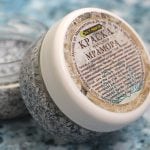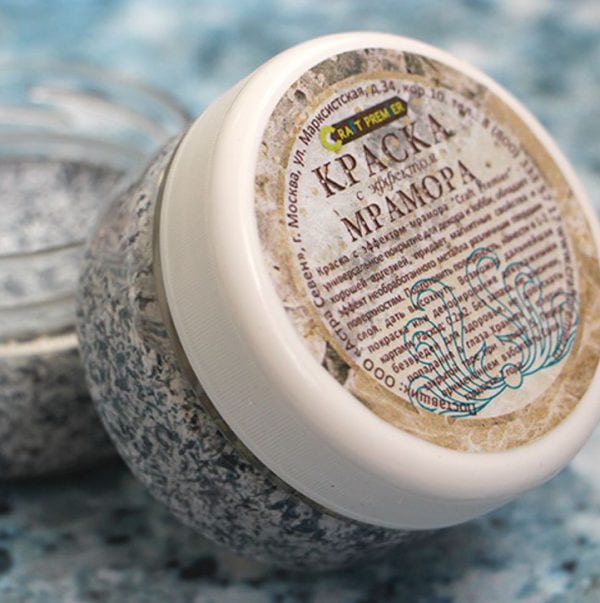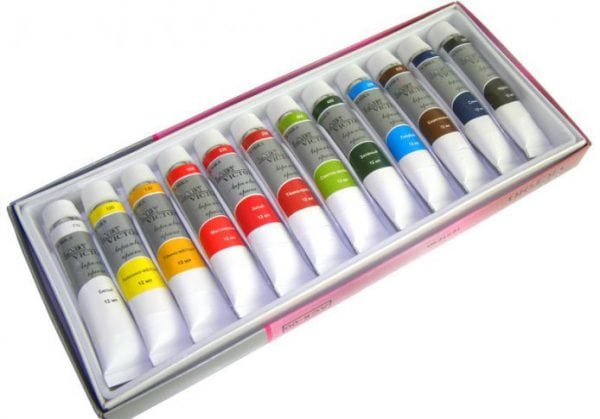Marbling is a decorative painting of a marbled surface. If the work is done efficiently, it is difficult to distinguish imitation from natural marble.
Color matching
For marbling you need paint in three different colors. One color will become the background. The color of this paint is selected taking into account the predominance of what color should be the result. It is recommended to buy paint with gloss (glossy, semi-gloss or semi-gloss).
If the basic background is dark, you will need a paint of the corresponding tonality (coal shade or maybe even black paint). To create a light background, you need to choose a white paint or paint material with small impurities of other colors (for example, yellowish white, light gray, yellowish brown). For example, to simulate green marble, you need dark green, gray-green and black paint.
To create veins, white paint is taken. However, you can use other colors - light green, light gray. Such colors are more contrasting.
to contents ↑Note! Two complementary colors should be similar in tone, but one of them should be darker.
Materials and Tools
- natural sponge;
- palette knife (thin elastic stick for applying soil);
- round bristle brush;
- brush for artwork (number 4 or 6);
- squirrel brushes (numbers 2,4,6 or 8);
- double brush;
- wide paint brush for processing wooden surfaces;
- paint in tubes.
Paint Instruction
- We are preparing the foundation. To do this, apply a couple of layers of white semi-matt alkyd paint to a wood panel cleaned from dirt and dust. Paint and varnish material should be distributed in even and smooth layers. Let the paint dry (waiting time for the first layer is 12 hours, for the second - 24 hours).
- To make the glaze, we take part of linseed oil into three parts of turpentine (can be replaced with white spirit) and add 2-3% of desiccant.
- Using a round bristle brush (width - 25 millimeters), we apply the glaze of two colors. We do this with arbitrary movements, but directed in one direction. Level the surface with a flat paint brush.
- Until the paint has dried, we carry out the surface treatment with a brush for texturing. To create a texture, we press the tips of the brush to the glaze, mixing the colors together. We spread the colors to all places not covered with glaze.
- We take a brush with soft bristles and carefully draw it over the surface treated with glaze. And, first of all, we pass perpendicularly to the applied glaze, and then - in the same direction.
- We draw with a brush for painting thin veins on a glazed surface. In this case, the brush wraps between the index and thumb. It is recommended to make streaks in the same direction as the glaze.
- Next, again take a brush with soft bristles and draw it along the veins (you need to mix them with the general color background).First, we conduct the brush perpendicular to the veins, and then - along the veins.
- When the surface dries, carefully clean the surface with sandpaper with fine grain. It is important not to leave scratches or other defects. After cleaning, the surface will acquire a matte finish.
- A small layer of dust will also improve the look. Apply varnish to the dust layer and let it dry. Now you can clean the surface and treat it with another layer of varnish. Alternating application of varnish with cleaning gives the panel a marble look.
There is another way to marbling. You will need an untreated or primed surface and paint in three colors. Paint material is poured into separate containers. With a damp sponge, take a small amount of paint in each dish. Gently blot a sponge and apply the material to the surface in random order.
to contents ↑Useful Tips
- Since marble is a natural material, you need to try to achieve maximum reliability of the result. When choosing a color, it is recommended to use a fragment of natural marble or at least its image as a sample.
- “Marble” you can paint not only the walls, but also many household items, for example, countertops, shelves and so on.
- Refined patterns are recommended to be applied with a thin pen.
- The easiest way is to apply paint to small areas, for example, on the panel under the dado rails.
- It’s more comfortable to work in pairs. One worker is engaged in glazing, the other works with different tools.
Marble staining is a difficult technique for decorating the surface. Such work requires skills and certain artistic abilities.
If there is no experience, it is recommended to practice before starting to simulate a marble surface.






